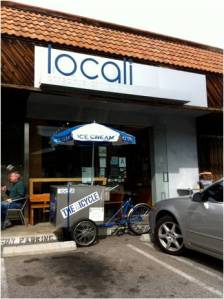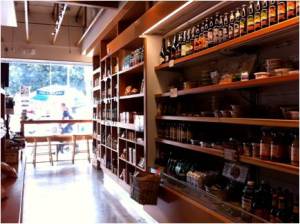If you asked the average American consumer to describe a convenience store, most would say it’s a place that sells junk food, lottery tickets and cigarettes. Ubiquitous in many other areas of the world, convenience stores are less common in the US. They also carry fewer goods, and tend to have a negative image, being associated with negative images such as frequent burglaries, unhealthy food and beverages, and dirty interiors. However, a new and interesting niche with a completely different image has appeared: eco-friendly convenience stores, branded “Econvenience stores,” have started opening across the nation and are becoming a new green/eco-trend.
Convenience stores in the US
Convenience stores have been in the US since 1927, when 7-Eleven began in Texas. Today there are a variety of stores across the country ranging from major chains (am/pm, 7-Eleven) to gas station mini-marts and local mom-and-pop stores. In the US, convenience stores are generally located in urban areas or along major roads and highways, making them easily accessible to shoppers who usually visit via car. Many convenience stores are connected to gas stations. Convenience stores typically offer snacks and processed foods (candy, potato chips, soda, etc.), lottery tickets, newspapers and magazines, and tobacco products. Depending on the location, they may also sell some groceries (including liquor and alcohol, depending on the state) or household goods. Prices, however, tend to be higher, and selections more limited compared to larger retailers. Although some convenience stores offer pre-packaged or hot food items, these tend to be unhealthy options such as pizza, burritos, hot dogs, and high-fat sandwiches. In response to an increasing demand for healthier items, many convenience stores have begun offering “healthier” options such as lower-calorie sandwiches, fresh salads and fresh fruit.
The “Econvenience store”
Vastly different from the typical American convenience store, “econvenience stores” sell natural and organic food and beverages, and focus not only on price and convenience, but also on health, safety, taste, and the environment. Note: In the US, demand for eco-friendly food (including organically grown, vegan-friendly, gluten-free, and local offerings) has skyrocketed, and such products are readily available in most major supermarkets. Americans spend billions of dollars each year on these items, and today there are major natural-food supermarkets that carry only organic and natural products. One of these companies, Whole Foods Market (http://www.wholefoodsmarket.com), is one of the world’s largest retailers of organic and natural food, with more than 270 stores in North America and the United Kingdom. Whole Foods carries only products that are minimally processed and that are free of hydrogenated fats, artificial colors, sweeteners, flavors and preservatives. Despite its higher prices, Whole Foods has become a popular and trendy place to shop, and its success has helped to make organic products more easily attainable and commonplace in American society. One could argue that it has also played a role in increasing awareness of eco-friendly products and practices (recycling, eco-bags, etc.). As a “hybrid” of the traditional convenience store (am/pm or 7-Eleven) and the large organic grocery store (Whole Foods), the econvenience store offers healthy and natural options together with the handiness of a convenience store (as well as the community feel of a local store). While the majority of American consumers still shop at local chain supermarkets and base their purchasing decisions on price, there are more and more shoppers who are concerned about where their food comes from and are willing to pay a little more, and drive a littler farther, to get the products.
The following are two examples of econvenience stores in the US:
1. Locali (http://www.localiyours.com)
One example of an “eco-friendly” or “econvenience” store is Locali Conscious Convenience, located in Hollywood, California. Locali, meaning “community” in Italian, calls itself “Your sustainable neighborhood market.” At first glance, Locali appears to be just a small, nondescript grocery store in a strip mall. However, upon entering the store you find a clean and hip market. The 7-Eleven-style fluorescent lights and shelves of processed foods are nowhere to be found–instead you see wood shelves (made from reclaimed wood) full of interesting local, organic goods. The interior also features energy-efficient appliances and lighting fixtures. According to the company’s website, Locali “aims to serve its community by providing eco-friendly products and healthy food and beverages from sustainable growers, artisans and suppliers.” While the shop caters to customers stopping by for to-go drinks or a bite to eat, there are plenty of unique organic and local products for sale. You can find everything from frozen organic food to natural teas and juices, local/sustainably produced wines, and natural snacks. Besides food and beverages, Locali also sells eco-friendly household and everyday items, including light bulbs, feminine products, household cleaners, hand sanitizer, and even lip balm. In addition, Locali offers a variety of natural and organic deli sandwiches; salads; beverages featuring reverse-osmosis water; antibiotic-, hormone-, gluten-, and casein-free meats; and locally made fresh, natural breads. All deli packaging and utensils are biodegradable and compostable. The shop encourages customers to bring their own reusable bottles and containers for both drinks and food. Another important aspect of the econvenience store is its involvement with the community. Locali does this by not only showcasing local products, but also by promoting local events and giving back to the community.
2. Green Spot (http://www.greenspotmarket.com)
The Green Spot Market & Fuels, another eco-friendly convenience store, opened for business in 2008 in Dallas, Texas, after the owners realized that many local consumers wanted to be more environmentally conscious and eat more healthily. Unlike a typical gas station and mini-mart, Green Spot doesn’t sell Snickers bars or bags of Doritos. Green Spot is a “Healthy Convenience” store where customers can find guilt-free natural snacks and drinks, and can also fill their cars with biodiesel fuel. The store specializes in healthy, organic, and wholesome products such as natural sodas, organic snacks, fresh flowers, gourmet sandwiches, organic/fair trade coffees, natural teas, and even organic diapers. You can still find Coca-Cola; however, it’s from Mexico, where it’s still made from real sugar. As at most organic grocery stores in the US, there are also numerous items for vegans. This convenience store also serves as a café offering healthy, organic meals made from only natural ingredients. In addition, Green Spot uses eco-friendly products, including cups and straws made from corn, utensils that are 100% biodegradable, and plates and bowls made from sugar cane. Even the wallpaper is made from used paper grocery bags. Green Spot is not just a natural market, but also a “green” gas station. Customers can purchase biodiesel-blended fuels (made from corn oil, soy oil, etc.) in two grades, 5 percent and 100 percent. Compared to regular fuel, biodiesel fuel is cleaner-burning and adds no carbon dioxide to the atmosphere. The biodiesel is also available for onsite fueling at events and festivals, including concerts. Green Spot hopes to educate consumers on both healthy eating options and being environmentally responsible.
Eco-friendly convenience stores are still relatively new and rare in the US. Those that do exist are quite small in size and usually frequented by a niche group of shoppers. However, the increasing popularity and demand for organic and health foods, as well as increasing awareness of the environment (and living in an eco-friendly way) are advantages for these stores. Other recently popular trends in the US such as environmentally friendly building practices; green businesses; products that are organic, natural, /safe, and/or clean; returning to the local community; and the ever-increasing need for convenience and saving time, are all areas that fit well with the concept of the econvenience store. As more and more consumers learn about these stores and the benefits they bring to not only individuals, but also communities, we are likely to see many more of them around the country.



